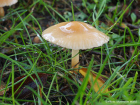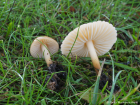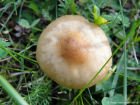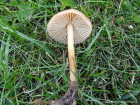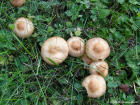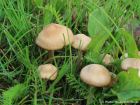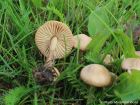Cap at first convex, then flat to cup-shaped with a low central hump that is often a darker shade. The Colour varies from light beige to brown-yellow. The margins are usually crinkled and almost transparent and streaky in damp weather. They turn lighter in dry weather and regain their colour in more humid conditions. The flesh is whitish buff, thick at the centre, otherwise thin. Gills fairly broad, attached to the stem or free from it, appearing almost distant. They are creamy white at first, becoming ochraceous cream or pale tan in colour. Stem tall, coloured as the cap, smooth or finely scurfy, slender, more or less equal, whitish downy at the base and slightly rooting, stiff. It has no ring. Spore print white.
Microscopic Features: The spores are ellipsoidal to pip-shaped, exhibiting a smooth surface. They measure 8-11μm in length and 4-6μm in width and are inamyloid.
Marasmius oreades on the First Nature Web site.
Marasmius oreades on the mykoweb.com Web site.
Marasmius oreades on the MushroomExpert.Com Web site.
Many mushrooms are poisonous, and some can be lethally toxic. Distinguishing between edible and poisonous mushrooms can be very challenging. Therefore, we strongly advise against consuming wild mushrooms. This website does not contain any information about the edibility or toxicity of mushrooms.
Although efforts have been made to ensure accuracy on this website, the information may contain errors and omissions. Therefore, all content provided is for educational and informational purposes only and should not be relied upon or used as a basis for consuming any plants or mushrooms.
External links are provided for reference only. We do not endorse or take responsibility for the content, advice, or products found on these sites or in any advertisements shown on this website.
